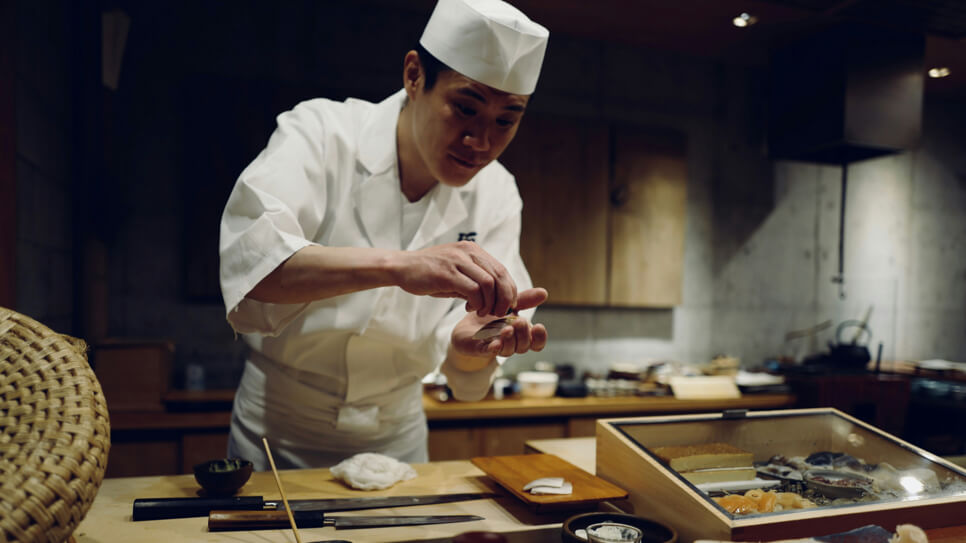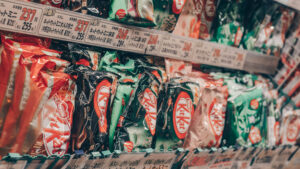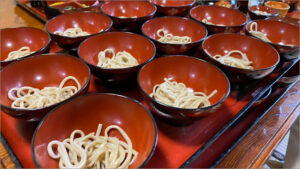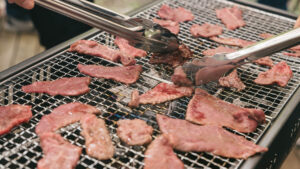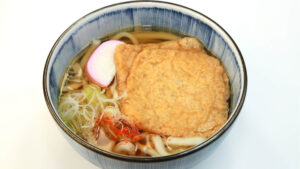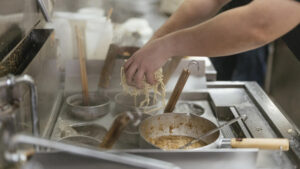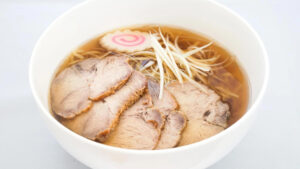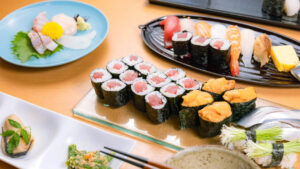If you’re visiting Japan, trying authentic sushi is a must. But what’s the difference between high-end sushi and conveyor belt sushi? It’s not just about the price—the charm and way of enjoying each are completely different. In this article, we’ll clearly explain the differences in ingredient quality, serving style, restaurant atmosphere, and even essential sushi etiquette, all in a way that’s easy for international travelers to understand. Discover helpful tips to find the sushi experience that’s perfect for you.
Contents
Key Differences Between High-End Sushi and Conveyor Belt Sushi
Differences in Price Range
High-End Sushi Can Cost Thousands of Yen per Piece
At high-end sushi restaurants, a single piece of sushi can cost anywhere from a few hundred to several thousand yen. This reflects not only the exceptional quality of the seafood used, but also the expert craftsmanship of skilled sushi chefs who carefully prepare each piece. The price also includes the overall dining experience—such as the restaurant’s location, interior design, service, and even the pairing with fine tableware and sake. Especially in “omakase” (chef’s choice) courses, the total cost per person can range from ¥10,000 to ¥30,000 (approximately $70 to $200 USD). These restaurants are often chosen for special occasions, business dinners, or celebrations.
Conveyor Belt Sushi Is Typically ¥100–¥500 per Plate
Conveyor belt sushi, or “kaitenzushi,” is one of the most common and affordable ways to enjoy sushi in Japan. At many kaitenzushi chains, each plate (usually containing two pieces) is priced between ¥100 and ¥500. Diners can freely choose what they like at their own pace. Despite the lower price range, there’s a wide variety of sushi available, and many restaurants offer side dishes and desserts as well. It’s a popular choice for families, students, and tourists looking for a casual and accessible sushi experience.
Understanding the Relationship Between Price and Value
There’s a significant difference in how “value” is perceived between high-end sushi and conveyor belt sushi. High-end sushi provides a special experience that combines premium ingredients, expert techniques, and a refined atmosphere—offering more than just a meal. It’s about savoring every element. In contrast, conveyor belt sushi emphasizes cost performance and the joy of freely selecting what you want to eat, making it perfect for casual gatherings. Each style has its own appeal, and choosing based on your purpose and budget is the key to fully enjoying Japan’s sushi culture.
Differences in Serving Style
Face-to-Face Service by Skilled Chefs
At high-end sushi restaurants, it’s standard to sit at the counter and dine face-to-face with the sushi chef. Each piece is crafted individually, timed to your pace and preferences—making the experience feel like a live performance. Watching the chef’s skillful techniques up close, and engaging in conversation, adds to the sense of intimacy and authenticity. Most of these restaurants follow an “omakase” course format, where the chef serves seasonal and recommended items in a carefully curated sequence. This style of service offers more than just a meal—it’s a refined and memorable experience.
Self-Service with Conveyor Belt Delivery
The hallmark of conveyor belt sushi restaurants is their self-service system, where plates of sushi travel along a rotating belt. Diners can freely choose what they want, when they want it, simply by picking a plate as it passes. This format is fun and accessible, with a wide variety of menu options and an engaging visual appeal that makes it popular among all age groups—from children to adults. Many chains also implement freshness tracking systems, such as time-limited circulation or automated plate removal, to ensure hygiene and food quality.
Touch Panels and High-Speed “Bullet Train” Lanes
In recent years, many conveyor belt sushi chains have adopted touch panel ordering systems. Diners can easily select their favorite sushi or side dishes from a screen, and their orders are delivered directly to their seats via a special express lane—often designed to look like a miniature bullet train. This system reduces order errors and ensures freshly made sushi is served promptly. It also helps overcome language barriers, making the experience more comfortable for international travelers. The combination of convenience and entertainment makes this a uniquely Japanese dining experience.
Different Dining Occasions
Special Occasions Like Anniversaries and Business Dinners
High-end sushi restaurants are often chosen for special occasions such as birthdays, wedding anniversaries, and business dinners. The quiet, refined atmosphere and the artistry behind each carefully crafted piece of sushi create a memorable and elegant dining experience. This luxurious style of sushi dining is also a meaningful way to express gratitude or respect to someone. In Japanese business culture, such establishments are commonly used to build and strengthen trust between colleagues and clients.
Casual Meals with Family and Friends
Conveyor belt sushi is beloved as an everyday dining option, thanks to its affordability and wide variety of choices. On weekends in particular, it’s common to see families with children or groups of friends enjoying a lively, casual meal together. With plenty of side dishes, desserts, and seasonal specials, even those unfamiliar with sushi can have fun. It’s easy to stop by, pick what you like, and share plates—making it a great choice for relaxed, social dining.
A Popular Option for Tourists
For international tourists visiting Japan, sushi is a must-try cultural experience. With limited time and budget, many travelers find conveyor belt sushi to be an ideal first stop. Most locations offer English menus, touch-screen ordering systems, and photo guides, making it approachable even for those who don’t speak Japanese. On the other hand, for those looking to dive deeper into Japan’s culinary heritage, a high-end omakase course can become an unforgettable highlight of the trip. Depending on your travel style, trying both types of sushi can offer a well-rounded and enriching experience.
Commitment to Ingredients: Comparing Quality and Sourcing
Freshness and Origin of Seafood
High-End Sushi Uses Fresh Seafood from Toyosu Market
To deliver the best possible flavor and texture, high-end sushi restaurants place great importance on the freshness of their seafood. Many of these establishments source their fish daily from Toyosu Market in Tokyo, which replaced the historic Tsukiji Market. Some chefs also purchase directly from specific fishing ports or select rare wild-caught species, relying on their expert eye to choose only the finest ingredients. The selection may change depending on the season or weather, making each visit a unique opportunity to enjoy the day’s best offerings.
Conveyor Belt Sushi Uses Frozen and Imported Ingredients
Conveyor belt sushi chains aim to offer a wide variety of menu items at affordable prices, often utilizing frozen seafood or imported ingredients. For example, salmon, shrimp, and tuna are commonly sourced in bulk from countries like Norway, Canada, and Indonesia. Advances in freezing technology help preserve freshness and flavor, but the quality may vary depending on the supplier and handling methods. Each chain puts effort into improving consistency, and these differences can significantly affect the overall taste and experience.
How to Check Seafood Sourcing Information
In Japan, many sushi restaurants—including major chains—clearly indicate the origin of their seafood. You may find signs or menu notes stating where items are sourced, such as “Hokkaido” or “Direct from Toyosu.” This is especially helpful for diners who prioritize ingredient transparency. Conveyor belt sushi restaurants are increasingly promoting their sourcing details, which helps build customer trust and ensures food safety. When dining, take a moment to look for this information—you might find seafood from across Japan and around the world on your plate.
Balance Between Toppings and Rice
High-End Sushi Is Optimized One Piece at a Time
At high-end sushi restaurants, chefs adjust the size, shape, and firmness of each rice ball (shari) based on the type, size, and fat content of the topping (neta). For instance, light white fish may be paired with a smaller amount of rice, while fatty cuts like otoro are often matched with larger, more vinegared rice portions. This delicate balance is calculated to ensure that the sushi feels harmonious and delicious the moment it enters your mouth. It’s a level of precision and artistry that elevates the experience to something truly exceptional.
Conveyor Belt Sushi Relies on Mass Production
Conveyor belt sushi prioritizes efficiency and consistency, so the rice is typically shaped by machines. Pre-sliced toppings are placed on the rice automatically, making it difficult to individually optimize each piece. However, recent innovations—such as high-precision rice-shaping machines and technology that adjusts based on topping weight—have improved quality significantly at some chains. While not handcrafted, this type of sushi strikes a practical balance between affordability and speed.
The Impact of Skilled Sushi Techniques
The “nigiri” technique used by skilled sushi chefs makes a major difference in flavor and texture. The rice is gently molded—firm enough to hold its shape, but soft enough to melt in your mouth. This perfect balance is the result of years of experience. Chefs also apply small adjustments, like folding the edge of the topping for a three-dimensional look or angling it slightly for visual appeal. While conveyor belt sushi maintains a certain level of quality, it’s this artisanal craftsmanship that often creates a more moving and memorable dining experience.
The Sushi Experience: More Than Just a Meal
Interaction with the Sushi Chef
Enjoying the “Omakase” Style
One of the most iconic features of high-end sushi restaurants is the “omakase” style, where you entrust the entire course to the chef. Based on the season and the day’s freshest ingredients, the chef carefully selects and serves each piece in the ideal order. This is not just about eating sushi—it’s about appreciating the chef’s creativity, technique, and sense of timing. The excitement of wondering “What will come next?” adds a sense of entertainment to this luxurious dining experience.
Conversations with the Chef Enhance the Experience
Sitting at the counter allows diners to speak directly with the sushi chef—an experience unique to high-end sushi establishments. Learning about the origin of ingredients, the chef’s personal techniques, and the story behind seasonal offerings adds depth to each piece of sushi. Many chefs are happy to answer questions and share their passion for the craft. This interaction transforms the meal into a cultural exchange and leaves a lasting impression well beyond the flavors alone.
Restaurant Atmosphere and Interior Design
High-End Sushi Shops Offer a Calm, Traditional Japanese Space
High-end sushi restaurants are designed to provide a serene, refined Japanese atmosphere. You’ll find wooden counters with beautiful grain patterns, soft indirect lighting, and carefully selected tableware and chopsticks that reflect the chef’s attention to detail. The space is thoughtfully curated to appeal to all five senses, eliminating unnecessary noise or decorations so diners can focus entirely on the sushi and the chef’s artistry. Many of these restaurants keep background music minimal or eliminate it altogether, making them ideal for quiet, adult dining experiences.
Conveyor Belt Sushi Restaurants Are Bright and Casual
In contrast, conveyor belt sushi restaurants feature a bright, casual interior aimed at families and younger customers. Colorful seating, cheerful background music, and visually engaging elements like rotating sushi lanes and touchscreen ordering panels create a fun, welcoming environment. In addition to counter seating, many locations offer booth-style tables that accommodate groups, making it easy for friends and families to dine together. The lively and friendly atmosphere reflects Japan’s accessible and modern dining culture.
Child-Friendly Features and Services
Many conveyor belt sushi chains offer features that cater specifically to children. These include kid-friendly menu items, small servings of steamed egg custard (chawanmushi), toy-dispensing machines (gachapon), and birthday perks. Child seats, stroller access, and clear allergy labeling are also common, making the experience comfortable for families. On the other hand, some high-end sushi restaurants may have age restrictions or discourage young children to maintain a quiet atmosphere. It’s a good idea to check in advance if you plan to dine with kids.
Reservations and Wait Times
High-End Sushi Usually Requires a Reservation
Most high-end sushi restaurants operate on a reservation-only or reservation-recommended basis. With limited seating and a style focused on one-on-one service by the chef, walk-in dining is often not possible. At especially popular establishments, reservations can fill up months in advance. Fortunately, many restaurants now accept bookings through English-language reservation platforms or hotel concierge services, making it easier for international travelers to secure a seat with confidence.
Conveyor Belt Sushi Offers Convenient Waitlist Systems
One of the advantages of conveyor belt sushi restaurants is that you can usually visit without a reservation. However, popular locations can get crowded during peak meal hours. Many chains have introduced convenient waitlist systems using in-store ticket machines or smartphone apps. These systems provide estimated wait times and even send notifications when your turn is approaching, allowing you to shop or explore nearby while you wait. It’s an efficient way to enjoy sushi without long lines.
Tips for Avoiding Crowded Hours
To minimize your wait at a conveyor belt sushi restaurant, try to avoid peak hours. Weekday lunch (12:00–13:00) and dinner (18:00–20:00) periods tend to be the busiest, especially on weekends and holidays. Visiting during off-peak hours, such as between 14:00 and 17:00, or right after opening or just before closing, often ensures a more relaxed dining experience. Many restaurants also offer real-time crowd information via apps, so checking ahead can help you plan a smooth visit.
Recommended Options for International Travelers
Which Type of Sushi Is Best for First-Time Visitors?
Start with Conveyor Belt Sushi for a Casual Experience
For first-time visitors to Japan, conveyor belt sushi is a great way to experience sushi in a relaxed and approachable setting. It’s affordable and lets you freely choose what you like based on your preferences, making it ideal even for those unfamiliar with sushi. Menus often include pictures and English descriptions, and touch-panel ordering systems are intuitive to use. With a wide range of side dishes like ramen, fried items, and desserts, it’s also perfect for groups or families. It’s a fun and easy introduction to Japanese sushi culture.
Discover Authentic Flavor Through High-End Sushi
If you want to dive deeper into the world of Japanese sushi, high-end sushi is the way to go. Each piece is crafted right before your eyes by a skilled chef, offering a rich experience in taste, aroma, and texture. The “omakase” course, where the chef chooses the best items of the day and serves them in an ideal sequence, is particularly special. Even for first-timers, many restaurants offer English-friendly service or interpretation support, allowing you to enjoy this sophisticated experience with confidence. It’s a unique chance to truly understand the depth and artistry of Japanese cuisine.
Choose Based on Your Budget and Travel Schedule
Whether to choose conveyor belt sushi or high-end sushi depends on your travel plans and budget. For shorter stays, conveyor belt sushi is convenient and accessible, while those with more time might enjoy the slow-paced, immersive experience of a fine sushi restaurant. Both styles offer insight into Japan’s rich sushi culture, so if possible, trying both will give you a fuller appreciation of the tradition and variety sushi has to offer.
Etiquette to Enjoy Sushi Even More
Is It Okay to Eat Sushi with Your Hands? How to Use Chopsticks
In Japan, it is perfectly acceptable to eat sushi either with your hands or with chopsticks. In fact, at high-end sushi restaurants, eating sushi by hand is sometimes recommended because it helps keep the topping and rice intact. When using your hands, gently hold the edge of the topping to avoid breaking the rice as you bring it to your mouth. If you use chopsticks, be careful not to squeeze too hard. Restaurants always provide a wet towel (oshibori) to clean your hands, so even those hesitant to eat with their hands can try it comfortably.
The Proper Use of Soy Sauce and Pickled Ginger (Gari)
Soy sauce and pickled ginger (gari) are essential accompaniments when eating sushi. The basic rule is to dip the topping—not the rice—into the soy sauce. Dipping the rice directly can cause it to fall apart and absorb too much salt. A smart way is to lightly turn the sushi piece over, like sashimi, and dip just the edge of the topping. Gari is meant to cleanse your palate between different pieces of sushi and is generally eaten separately rather than together with the sushi.
How to Order and Enjoy the “Omakase” Experience
At conveyor belt sushi restaurants, ordering is usually done via touch panels or directly with staff. Many places offer English menus, making it easy for first-timers to navigate. At high-end sushi restaurants, the common practice is to order “omakase” (chef’s choice), where the chef serves the freshest seasonal ingredients in the best order. Using simple Japanese phrases like “onegai shimasu” (please) when ordering gives a polite impression. Choosing omakase lets you relax and fully enjoy the chef’s skill without worrying about what to order.
High-End Sushi or Conveyor Belt Sushi: Find the Style That Suits You
High-end sushi offers a special experience where you can savor the craftsmanship of skilled chefs and carefully selected ingredients. Conveyor belt sushi, on the other hand, is a casual and accessible part of Japan’s unique food culture. Both have their own charm, and you can choose depending on the occasion, budget, and length of your stay. Even if it’s your first time trying sushi, there’s no need to worry. Knowing a little about etiquette and how to order will make your sushi experience even more enjoyable and delicious. Be sure to find the sushi style that fits you best and fully enjoy Japan’s culinary traditions.
